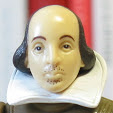A Midsummer Night’s Dream. Dir. Joe Dowling and David Bolger. Perf. Jay Albright, Darius Barnes, Joe Bigelow, Nicholas Carriere, Eleonore Dendy, Michael Fell, Alex Gibson, Casey Hoekstra, Nike Kadri, Zach Keenan, Emily Kitchens, Tyler Michaels, Kris L. Nelson, Christina Acosta Robinson, Peter Thomson, Angela Timberman, Tony Vierling, and Andrew Weems. Guthrie Theatre Company. Minneapolis. 7 February—29 March 2015.
Right: Tyler Michaels, as Puck, is sent with broom before to sweep the dust behind the door. Production photo by Dan Norman.
Last night, a group of students and faculty went down to the Guthrie Theatre to see their
Midsummer Night’s Dream.
If that sentence sounds familiar, it may be because I used it already—back in 2008 (for which,
q.v. and the two posts that follow it). This, the 2015 performance, has many of the same qualities and some of the same directorial decisions as the 2008 production, but it's different in a number of ways, not the least of which is that it is Joe Dowling's final production for the Guthrie.
Last time, my organizational principle included four categories: "overall impressions, things that worked, things that didn’t work, and things that might work for some but won’t work for others." This time, I have a list of things that are striking about the production.
The play's opening line.
I had heard that the production was going to be a longer one than most. "Uncut" was the word often used to describe it, together with the notation that those who have seen the play before will likely see scenes they've never seen before. I was, therefore, a bit surprised when the opening line came:
Hippolyta, I woo'd thee with my sword,
And won thy love, doing thee injuries;
But I will wed thee in another key,
With pomp, with triumph and with revelling. (I.i.17-21)
With that powerful beginning, one of the key themes of the play starts to develop. The lines were delivered in a no-nonsense manner, as if Theseus were telling Hippolyta that she had better see to it that her attitude is not one of injury but one of pomp instead. We lose the first sixteen lines of the play, which can do something of the same, but not quite as economically; in exchange, we gain an immediate understanding of the tensions between the two. But we also lose the opening moon imagery, which I consider to be important in establishing a different set of concerns.
The relationship between Hippolyta and Theseus.
Arising out of the opening line, this production developed the relationship in a similar way to the 2008 version. I made the following note on that production:
When [Theseus] asks [Hippolyta] to come with him in Act I, she deliberately exits in the opposite direction. When he asks her to come with him in Act V, she willingly acquiesces. I thought it was effective. It’s a slow character development.
The 2015 production does the same, but with some refinements. When Egeus says that his daughter must either marry the man of his choice or face the death penalty, Hippolyta cannot keep from uttering a horrified "No!" Combined with other business, that makes Hippolyta's exiting without Theseus not the result of his doing her injuries but of his inability to act as she wishes him to act in the matter of Hermia's situation. In Act IV, Theseus seems almost ready to side with Egeus in his anger with Hermia's being found with Lysander and with every intention of marrying Lysander—until Hippolyta coughs gently and steers him toward overriding Egeus' demands. Upon her exit in that scene, she winks at Hermia as if to say, "Here's how you handle a man."
The Indian Boy.
The subtitle for this section could be "The relationship between Oberon and Titania." The main argument between the two of them is Oberon's determination to take over the raising of the Indian boy and Titania's refusal to let him do so. Nothing in the text demands that an actual boy be present, but different productions have done interesting things with the idea of the character—including making him any age between infant and thirty-five. Here, it's an infant wrapped in a blanket.
Oberon's plan is to make Titania fall in love with something ridiculous so that he can take the Indian boy from her. That plan motivates much of the action of the play—getting the love potion to use on Titania means it's available to use on (accidentally) Lysander and (purposefully) Demetrius. And Oberon's plan works—while Titania is in love with Bottom the Weaver (with an ass head on his own), he gets control of the Indian boy.
Quite interestingly, this production brings the Indian boy back on in Act IV, once Titania's love-potioned eyes have been treated with the antidote. While she is asking—really, demanding—how these things have happened, the boy cries, and he is handed to Titania. Though Puck makes a motion toward getting the boy back, Oberon restrains him.
Let me pause the play at that point to allow us to sit in a most interesting suspense. Will she claim the child back? Will Oberon allow her to do so? Will she surrender him to Oberon—willingly, this time? Will the two come together to raise the child, strengthening their own relationship as they concentrate their efforts on taking care of this little one?
Instead of developing these (or other) possibilities, the play just has Titania hand the child back to (as far as I could tell) a random fairy, who then takes it offstage. I think the production squandered an intriguing issue that it raised there.
Guthrie asides.
In most Guthrie production of Shakespeare that I've seen, there have been numerous extra-textual lines from the actor. These are lines like "No!" or "Duh!" or "Yeah, I guess" or even "Did you know he was a boy?" inserted into the dialogue. They often get a laugh—but it's usually a cheap laugh. I'm of two minds about these Guthrie asides. They do distract from the text (and not always in helpful ways), but they also can help elucidate something in the text that might be on the obscure side. For now, I'll just put it down to Guthrie House Style—it's how they do Shakespeare.
Underwear.
According to my previous post, in the 2007 production, "When the lovers enter the woods, their clothes are wisked away, leaving them in their underwear (though they don’t seem to notice until they are discovered by Theseus and Hippolyta late in Act IV)." In that production, it seems to indicate freedom from societal conventions in the woods outside Athens. In this production, Hermia and Lysander's clothes are removed in a darker, more troubling, forcible way by what seem to be quite malicious fairies. They're not just entering into a place of freedom; their hitherto surface identities are violently stripped from them. Demetrius and Helena have their clothing removed as well, but in more of a natural way that they seem neither to notice nor to resist. I'll have to ponder whether the difference is intentional.
Into the [Scary] Woods.
This production provides a wood that is often very frightening. It's not just a foil for the regularity of Athens; it's an otherworldly place that is frequently menacing. Particularly vivid along these lines is the presentation of the wood after Lysander leaves Hermia. She wakes and cannot find him. The lighting becomes dark and threatening. Fairies approach in a very menacing way. Helena is genuinely terrified. She becomes an extremely vulnerable, solitary woman in the woods in just her underwear in the darkest part of the night with either ambivalent or actively hostile forces around her. Demetrius' line to Helena about doing her "mischief in the woods"(II.i.237) is nothing—as Helena points out, his "virtue is [her] privilege" (II.i.220)—she has nothing to fear from him. But Hermia may have much to fear from these fairies, whose virtue is not clearly known to anyone.
Administration of the Love Potion.
In most productions, the administration of the love potion is either nothing particularly interesting or has some comic value. I recall one production where the Puck made a hilarious "Squeeekie Squaaak Squissssh" noise whenever applying the potion. This production chooses to make its administration a difficult and painful matter. The fairies who give it raise up the patient and then force an invisible power into their eyes, causing them to groan in pain and to resist. It's an intriguing choice that heightens the intrusion the fairies are making into human life.
The "Jack Shall Have Jill" song.
A great deal of song and dance infuses this production. As in 2007, "there was a very funny Doo-wop version of the lullaby the fairies sing to Titania in II.ii. The head fairy on that number had a lovely, soaring voice, and the “Diana and the Supremes” choreography was pleasing." As in 2007, Puck’s attempt to rap “Yet but three? Come one more. / Two of both kinds makes up four” (III.ii.437-38) slowed up the action and was fairly embarrassing."
[Note: Doesn't the Guthrie read Bardfilm when preparing their productions?]
One of the best of the numbers is Puck's "Jack shall have Jill; / Nought shall go ill" (III.ii.461-62). At first, it's just Puck; the main female fairy soon joins him. Later, the four sleeping lovers are magically animated to sit up and sing a Doo-wop backup to the number. It was hilarious and extremely well choreographed and performed.
Rude Mechanicals.
As per usual, the play-within-the-play steals (at least for a time) the show. It was full of good, entertaining business—including the single longest death of a Bottom that I've ever seen, three separate and progressively more elaborate dresses for Thisbe, a Wall that hits back, and a fake dog on a leash that gets stomped flat at one point. The only critique here is the character of Snug / Lion. He's directed as a drunk, which means that many of his good lines were lost.
Miscellaneous.
I wonder if the character of Peter Qunice, the Mechanical who directs the rest of the Mechanicals in their play, owes anything to Joe Dowling. I got the feeling that the soul of the director was humorously being invoked in his portrayal.
The 2008 production was notable for its use of military uniforms for Egeus and Demetrius, creating a bond between the two that was not shared by Lysander. This production also has military uniforms—but for everyone. It emphasis the notion that there is little to differentiate Demetrius and Lysander—apart from the love Hermia has for the latter and not the former.
For this production, the Guthrie had removed the back wall of the theatre, replacing it with seats to turn the Wurtele Thrust Stage into the Wurtele Stage in the Round. It made for a production that was full of motion, but it also drastically changed the acoustics in the theatre. Many of the actors were having to shout rather than to project, and shouting is not necessary when the theatre is arranged in its usual configuration.
Final blessing.
Oberon's final blessing over the three new marriages and the one restored marriage in the play is quite lovely:
With this field-dew consecrate,
Every fairy take his gait,
And each several chamber bless,
Through this palace, with sweet peace,
And the owner of it blest
Ever shall in safety rest. (V.i.415-20.)
The blessing is a big singing number involving all the fairies surrounding the stage and than advancing into the audience. An alert audience member who attended with me very astutely pointed out that it may be Joe Dowling's final wish for the Guthrie Theatre and its audience.
Thank you, Joe, for many years of brilliant, amazing, thoughtful Shakespeare—and for all the incredible thought that it inspires.
Links: The Play at the Guthrie's Web Site.
The Rude Mechanicals, in their "Athens Community Theater" jackets, provide a prologue.
Production photo by Dan Norman.
























%2Bcopy.jpg)




















